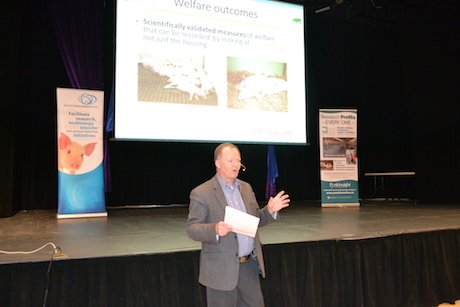The new Pig Code, the one that lays out how farmers must treat their pigs is getting good reviews. Florian Possberg, the chair of the National Farm Animal Care Council’s Pig Code Development Committee is confident Canada’s new Pig Code of Practice will help boost the international marketing position for Canadian pork.
There was much consternation from many in the hog industry that the Pig Code would cripple even more, and much misaligned hog industry in Canada.
However, producers around the table developing that Pig Code, and many not sitting on their hands at home, but writing nearly 5,000 submissions making  sure the producers, and not only the pigs could live with this new code.
sure the producers, and not only the pigs could live with this new code.
The new Pig Code of Practice contains key changes in the areas of housing for gestating sows, pain relief during painful procedures, and space allowance for pigs.
Possberg says the initial reaction of producers, animal welfare groups, and the retail sector to the new code is positive.
“Because it’s a sound well thought out process it’s something that we can use to promote our level of welfare that we use in Canada,” he said. “It’s a very reasonable well thought out process and it’s one that really focuses on the welfare of the animals and the practicality of the producers to treat the animals well. So I think it really puts us in a good place in terms of both domestic marketing and international marketing.
Possberg says this process is unique to Canada. In other jurisdictions, the process is top down where legislators have imposed their view of what animal welfare should be in their jurisdiction.
“In some places it seems like it’s a war between animal activists and producers,” he said. “I think in Canada we have a system, that uses science, various interest groups, best interest and, at the end of the day, I think in Canada we come to a place where our animals are much better off for our very sound system that we use.”
Possberg says the industry can be proud of the code of practice process that Canada can use for all of the major species of animal agriculture.
Lee Whittington, the president and CEO of the Prairie Swine Centre agrees adding the new Pig Code creates a win win situation for the animals, for the pork producer, and for society in general.
The Prairie Swine Centre is one of several research organizations that provided research data to the scientific committee that advised the 17 member Pig Code Development Committee.
Whittington says the broad public involvement in the process created this win win situation.
He thinks one of the important aspects of this negotiated code is it represents the best thinking and informed by science of the time.
“It involves not having litigation and various types of political pressures upon it which has been typical in other parts of the world where welfare not just for pigs but welfare for domesticated livestock is involved,” says Whittington. “So I think this code is a real win from that perspective because it considers the pig, it considers the science of what we know and it considers the needs of the pork producer.”
Whittington says the next couple of steps will be for the industry to review the code and incorporate it into the animal care assessment which is part of the Canadian Quality Assurance Program.
“From there I expect the various deadlines to flow from the code into the Animal Care Assessment so we’re really looking at the first changes within the next two years.
For many producers, as it pertains to changing to group housing, moving away from sow crates, doesn’t really affect them until they want to build new barns because after July 1, 2014, all new barns must have group housing for sows, and more pig space. While farmers in Manitoba would like to build new in some cases, the current hog barn expansion ban keeps a lid on that scenario.
So for now, it is business as usual. •
— By Harry Siemens




